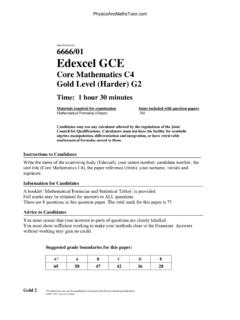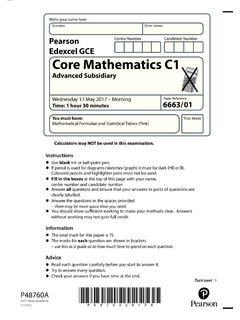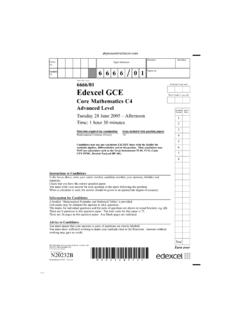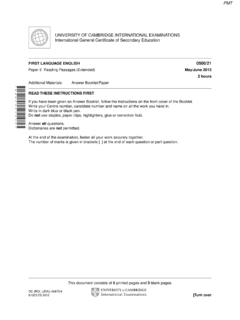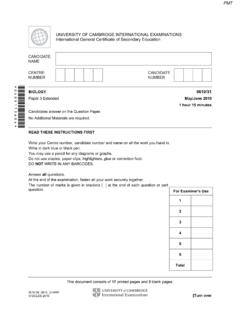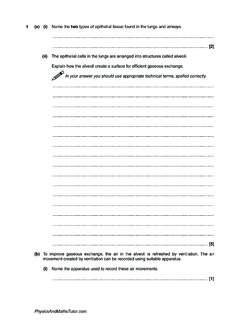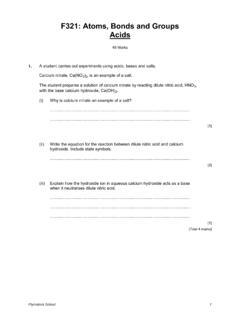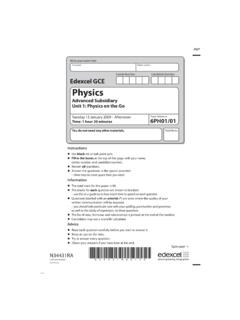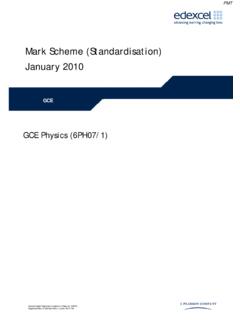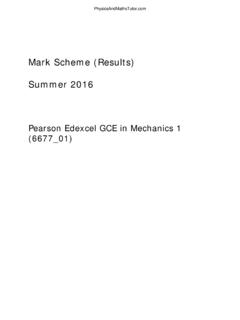Transcription of 1. Answers should be written in continuous prose. Credit ...
1 PMT. 1. Answers should be written in continuous prose. Credit will be given for biological accuracy; the organisation and presentation of the information and the way in which the answer is expressed. Read the following passage. photosynthesis takes place in the chloroplasts. These are disc-shaped organelles surrounded by an outer envelope consisting of two layers of membrane. Inside, there are further membranes which are arranged in stacks called grana. Surrounding these is the stroma. Chlorophyll and other light- capturing pigments are found on the membranes of the grana and it is here that the light-dependent reaction takes place. This generates the ATP and reduced NADP which are used in the light-independent reaction in the stroma. (a) (i) Describe the way in which ATP and reduced NADP are produced in the light-dependent reaction of photosynthesis .. (5). (ii) Explain how ATP and reduced NADP are used in the light-independent reaction of photosynthesis .
2 (4). PMT. (b) Using the information in the passage, describe how the structure of a chloroplast is adapted to its function in photosynthesis .. (3). (Total 12 marks). 2. (a) The diagram summarises the light-independent reaction of photosynthesis . Carbon dioxide ATP ADP + Pi RuBP GP Triose phosphate Hexose ADP. Reduced NADP. NADP. ATP. (i) Complete the four boxes to show the number of carbon atoms in a molecule of each substance. (1). (ii) Where in the chloroplast does the light-independent reaction take place? .. (1). PMT. (iii) Explain why the amount of GP increases after a photosynthesising plant has been in darkness for a short time.. (2). (b) Describe the role of water in the light-dependent reaction of photosynthesis .. (2). (Total 6 marks). PMT. 3. The island of Surtsey was formed in 1963 by a series of volcanic eruptions. Biologists have studied the colonisation of this new island by plants and animals.
3 (a) The graph shows the number of species of plants found on the island each year for the first seven years of its existence. 16. 14. 12. 10. Number of species 8. 6. 4. 2. 0. 1963 1964 1965 1966 1967 1968 1969 1970. Year The development of the plant community on Surtsey illustrates the process of succession. Explain why: (i) very few species could grow on the island in the first few years after it was formed;.. (1). PMT. (ii) once some plants were growing, the rate at which new species could establish themselves increased rapidly.. (2). (b) Animals also colonised Surtsey. One conclusion drawn from studying them was that particular species of animals found here had broader ecological niches than they did on the nearby mainland. Suggest why.. (1). (Total 4 marks). 4. Answers should be written in continuous prose. Credit will be given for biological accuracy, the organisation and presentation of the information and the way in which the answer is expressed.
4 Read the following passage. The living state requires a constant input of energy, and the most fundamental difference between animals and plants is the way they obtain their energy. Animals take in food - organic compounds - and release chemical energy during respiration; green plants absorb light energy from the sun, converting it to chemical energy in the process of photosynthesis . Source. adapted from (ED), Plant Physiology (Hodder and Stoughton, 1991). PMT. (a) Describe how plants absorb light energy from the sun and use this energy to produce useful substances in the light-dependent stage of photosynthesis .. (5). (b) Describe how the products of the light-dependent stage of photosynthesis are used in the Calvin cycle and how carbohydrate is synthesised as a result of the cycle.. (6). (c) Describe the similarities between photosynthesis and respiration.. (6). (Total 17 marks). PMT. 5.
5 The diagram shows the flow of energy through a marine ecosystem. The units are kJ m 2 year 1. Light energy measured at sea surface 10 5. 6250. 1000 Respiration 1250. Producers 4000. 500 Respiration 2800. Primary consumers 700. 100 Respiration 550. Secondary consumers 50. Energy in faeces and dead organisms which fall to the bottom (a) (i) Calculate the percentage of the light energy at the sea surface which is converted into chemical energy in the producers. Show your working. (2). (ii) The percentage of the light energy at the sea surface which is converted into chemical energy in the producers is very small. Give two reasons for this. (2). (b) Use the information in the diagram to explain why marine ecosystems such as this rarely have more than five trophic levels. (2). (c) What happens to the energy in faeces and dead organisms which fall to the bottom of the sea? (2). PMT. (d) Light energy is important in the light-dependent reaction of photosynthesis .
6 The energy changes which take place in the light-dependent reaction are shown in the diagram. Chain of electron carriers Chain of electron carriers Energy Reduced Level NADP NADP. ATP. Light ADP + Pi Chlorophyll Light Chlorophyll (i) Describe what happens to the chlorophyll when it is struck by light. (2). (ii) The weedkiller DCMU blocks the flow of electrons along the chains of electron carriers. Describe and explain the effect this will have on the production of triose phosphate in the light-independent reaction. (3). (e) Living organisms release energy from organic molecules such as glucose during respiration. Much of this energy is used to produce ATP. Explain why ATP is better than glucose as an immediate energy source for cell metabolism. (2). PMT. (f) The production of ATP is said to be coupled to the transport of electrons along the carrier chain. Normally, electrons are only passed along the carrier chain if ADP is being converted to ATP at the same time.
7 When the amount of ADP in a cell is low, electrons do not flow from reduced coenzyme to oxygen. (i) Suggest how the rate of respiration is linked to the needs of the cell. (3). (ii) DNP is a substance which allows electron transport to take place without the production of ATP. When DNP is given to rats, their body temperatures rise. Explain why. (2). (Total 20 marks). 6. (a) The diagram shows part of the light-independent reaction of photosynthesis . reduced NADP NADP. 2 molecules 2 molecules ribulose of of bisphosphate + CO glycerate triose (RuBp) 3-phosphate phosphate (GP) (TP). ATP ADP + Pi [5C] [3C]. (i) How many carbon atoms are there in one molecule of glycerate 3-phosphate? .. (1). (ii) What is the function of each of the following in the reactions shown in the diagram? Reduced NADP .. ATP .. (2). PMT. (b) Radioactive carbon dioxide was supplied to a culture of photosynthesising single-celled algae.
8 At 5-second intervals, samples of the culture were dropped into boiling alcohol to stop all chemical reactions. The radioactive substances identified in these samples are given in the table. Time / s Radioactive substances identified 0 carbon dioxide 5 GP. 10 GP, TP. 15 GP, TP, ribulose phosphate, glucose 20 GP, TP, ribulose phosphate, glucose, RuBP. Explain how information in the table provides evidence for the following. (i) Glycerate 3-phosphate is converted into triose phosphate.. (1). (ii) The reactions given in part (a) form part of a cycle of reactions.. (1). (Total 5 marks). 7. Limpets are animals which live on rocky sea shores. When the tide is out, a limpet is firmly attached to the rock by a muscular foot . Taller limpets are more likely to be dislodged by wave action. Variation in the size of limpets was investigated on two shores, A and B. The height and width of each limpet was measured as shown in the diagram.
9 Shell Height, H. Foot Width, W. PMT. The results of the investigation are given in the table. Shore A Shore B. Mean H W. Standard deviation Sample size 28 33. H. (a) (i) On which shore did the limpets have a greater variation in values of ? W. Give evidence from the table for your answer.. (1). (ii) Which shore had limpets that were better adapted to withstand wave action? Use evidence from the table to explain your answer.. (3). (b) (i) In investigations like this, why is it necessary to collect data from a large number of specimens which are selected at random? .. (2). PMT. (ii) Describe how you would select limpets at random.. (3). (c) Red seaweeds are algae which contain, in addition to chlorophyll, a red pigment called phycoerythrin. Green seaweeds do not contain phycoerythrin. Both phycoerythrin and chlorophyll absorb light energy which can be used in photosynthesis . The graphs show the percentage of light of different wavelengths absorbed by sea water, by chlorophyll and by phycoerythrin.
10 80. 60. Absorption by 40. seawater/%. 20. 0. 400 500 600 700. Phycoerythrin Chlorophyll Absorption by plant pigments 400 500 600 700. violet blue green yellow orange red Wavelength / nm and colour of light PMT. Use information from the graphs to explain why red seaweeds are usually found in deeper water (further down the shore) than green seaweeds.. (6). (Total 15 marks). 8. ATP links energy-releasing (exergonic) reactions with energy-requiring (endergonic) reactions. The diagram shows some of these reactions. Glucose + oxygen ADP + Pi Proteins 1 2 3 4. Carbon dioxide + water ATP Amino acids (a) Give the numbers in the diagram that correspond to exergonic reactions.. (1). PMT. (b) Explain why the total energy released from an exergonic reaction is not all available for the linked endergonic reaction.. (1). (c) The diagram shows some of the reactions of respiration. Glucose Triose phosphate Pyruvate Lactate Acetylcoenzyme A.
